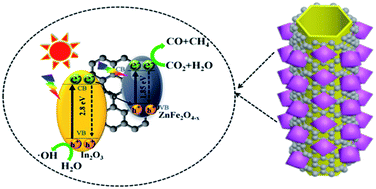A Z-scheme ZnFe2O4/RGO/In2O3 hierarchical photocatalyst for efficient CO2 reduction enhancement†
Abstract
Indium oxide (In2O3)-based photocatalysts have great potential in photocatalytic CO2 reduction. Nevertheless, their photocatalytic activity is inhibited by rapid electron–hole recombination. Hence, a novel Z-scheme ternary hierarchical ZnFe2O4/RGO/In2O3 photocatalyst is fabricated for photocatalytic conversion of CO2 to CO and CH4. The CO production rate reaches up to 35.4 μmol g−1 under 4 h of illumination using a 20ZFO/10RGO/IO catalyst, which is 3.9 times and 9.8 times higher than those using bare In2O3 and bare ZnFe2O4, respectively. The CH4 production rate is 7.8 μmol g−1, which is 4.3 fold and 2.4 fold higher, respectively, compared to those from bare In2O3 and bare ZnFe2O4. The enhancement of photocatalytic CO2 reduction was ascribed to a Z-scheme mechanism of the hierarchical catalysts by introducing RGO in-between In2O3 and ZnFe2O4 to promote charge separation and realize efficient utilization of the high-energy electrons and holes. The oxygen-defect of ZnFe2O4 also facilitates the adsorption and activation of CO2. This work provides new insights to design ternary In2O3-based hierarchical photocatalysts with a rational Z-scheme photocatalytic mechanism to improve the CO2 conversion efficiency.



 Please wait while we load your content...
Please wait while we load your content...